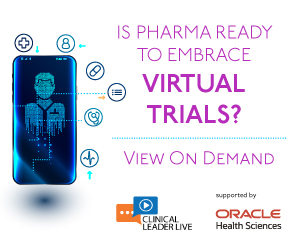Post COVID-19: Clinical Trials Will Never Be The Same

By Ed Miseta, Chief Editor, Clinical Leader

For years, technology and software companies, as well as CROs, have been pitching the benefits of patient-centric technologies to sponsor companies. Although a small number of pharma companies have been early adopters of these technologies, others seemed to be taking a wait-and-see approach. COVID-19 has changed that.
FDA guidance on protecting the safety of patients suddenly has sponsors scrambling for technologies that will allow them to gather patient data without having them travel to hospitals and clinics. Many companies are also contacting IRBs for guidance on modifying protocols to better accommodate patients.
I took this opportunity to speak with Donald Deieso, Ph.D., chairman and CEO of WCG. The company is comprised of two divisions – an Ethical Review Division (WIRB-Copernicus IRB), and a separate Clinical Services Division. Deieso was able to provide insights on the current state of clinical trials, and where we can expect the industry to go from here.
Ed Miseta: The COVID-19 pandemic caught a lot of pharma companies and sites by surprise. How are companies now attempting to monitor patients while keeping them safe?
 Donald Deieso: I hate to say this, but what I’m seeing are moments of desperation as they try to protect their patient participants during this pandemic. Sponsor companies and sites are calling on technology and service providers to ask what can be done and done quickly to preserve trial activities. They want to know what Zoom can be used for. They want to know if it is HIPAA compliant. They want to know how they can use SharePoint, WebEx, and FaceTime to interact with patients.
Donald Deieso: I hate to say this, but what I’m seeing are moments of desperation as they try to protect their patient participants during this pandemic. Sponsor companies and sites are calling on technology and service providers to ask what can be done and done quickly to preserve trial activities. They want to know what Zoom can be used for. They want to know if it is HIPAA compliant. They want to know how they can use SharePoint, WebEx, and FaceTime to interact with patients.
Sites and sponsors are frantically trying to find anything that works, because in this emergency situation there is not enough time for them to explore implementing remote enterprise solutions. That would take too long to install, integrate, and implement. This is a moment in which doing what works must become the priority.
Miseta: For years, companies have been offering new and innovative technologies to make clinical trials faster, more efficient, and better for patients. Unfortunately, the conservative nature of the industry has led to a very slow adoption rate. Is COVID-19 changing that resistance?
Deieso: Absolutely. The Conference Forum puts on a great event every year called Disruptive Innovations. At each of these conferences they conduct a contest called DPharm Idol. A panel of judges from pharmaceutical companies hears presentations and demonstrations from progressive companies followed by a vote on the best new technology likely to improve clinical trials. Sadly, few of those technology winners were ever adopted by the industry.
For me, the failure to adopt innovative approaches was always a frustration on both a business and personal level. Some of the finest technologies were showcased that would improve trials, but they became casualties of a cautious, no-change environment in biopharma. It’s disappointing that it took a once-in-a-century pandemic to overcome this resistance to change. The good news is the industry will not be able to put this genie back in the bottle. Sponsors and sites are struggling right now, but they are seeing what progressive approaches can do to their benefit.
Miseta: I recently spoke to Craig Lipset and Jeff Kasher. Both agreed these emergency measures being implementing today must become the best practices of tomorrow. Do you agree?
Deieso: Yes. Many of these technologies are definitely here to stay. In this moment of need, sponsors are finally seeing the advantages of these solutions. We have a lot of resistant-to-change thinkers inside Big Pharma who were afraid to take prudent risks. COVID-19 has taken away alternatives and they no longer have a choice. We can certainly say, “It’s about time.”
Miseta: Can you share any stories you have heard from the front lines?
Deieso: Sure. I believe we are now using telehealth like never before. Yesterday I was on a conference call with a major research institution. Prior to the pandemic, they performed about 20 telehealth appointments to support their clinical trials. In the last two weeks they have performed over 2,000. The reason is they no longer have a choice in communicating with patient participants. We remain confident that they will discover that staff and patients prefer it. Patients will welcome the option of not having to travel for those appointments and risk getting sick. When you think about it, the face-to-face model we have been using for some trials needs to be modified to accommodate technological advances.
To provide a little background on this, the notion of brick-and-mortar solutions in healthcare and clinical trials is a descendant of how financial incentives were derived. Payers, whether it was insurance companies or Medicare and Medicaid, required face-to-face meetings often as a condition to warrant the fee-for-service model. There are specific instances in which that model is archaic in today’s high-tech world.
We are at a point where technology has improved nearly every facet of our lives – clinical trials is one of the last frontiers. There are hurdles we will still face, with the current needs, I now see companies overcoming them on the fly. Existing healthcare and clinical models are being disrupted and will continue to be disrupted by progressive companies, sites, and patients. When it comes to new technology implementation, I feel more optimistic now than I’ve felt in more than a decade.
Miseta: Today, patients requiring an infusion must still visit a hospital or clinic. Oftentimes those patients are the most immune-compromised. Will that situation change?
Deieso: It has to. Remote visits are part of the future of clinical trials. Today, 50 percent of drugs are biologics. The pandemic has taught us that sites can and will stop seeing patients. Home healthcare is a sector that will pick up and home infusions are going to be an important part of that. Whether it’s measuring a patient’s vitals, drawing blood, collecting data, or infusions, there will be an imperative to do all of that remotely. And we also have to figure out how to reliably ship clinical trial experimental treatments directly to patients and confirm that they received it.
Miseta: For companies scrambling for help for remote solutions, what information should they have available when they call on solution providers?
Deieso: The first thing you will likely be asked is the therapeutic area of your clinical trial. If you are running an oncology trial, the questions you will be asked are very different than they would be for a diabetes trial.
Next, they will want to know what data you need to acquire from your patients and whether it can be done remotely. In some situations, like a behavioral health study, you will also have to consider whether information you’re collecting from patients is reliable. For many patients, simply having them record how they feel in an eDiary won’t be sufficient. The therapeutic area of the trial is going to be the most important determinant of whether or not we can engage remotely. If the therapeutic area requires deeper clinical insights, a tele-visit from a medical practitioner, who can be advised of the patient’s clinical measurements by patient-operated biosensors, might be a better solution. Sponsors and sites place a priority on keeping patients safe during a trial – especially in the COVID-19 era. But if a patient requires an infusion of a fragile biologic drug, there are few alternatives to coming into the clinic. That leads into another discussion on steps that must be taken to keep patients safe under those conditions.
Miseta: Do you have any advice for sponsor companies on what they can do to help their sites get through this crisis?
Deieso: The first thing they can do is help with the communication loop. Communication is everything right now. If a site does not have staff available to communicate with patients, the sponsor should be willing to help. Sponsors can’t speak to patients directly, but an authorized clinical service provider covered under HIPAA can. Sponsors can work with sites to make that happen. Reputable clinical service organizations will meet all HIPAA obligations and protect patient information. Once you deputize them, they can speak to the patients directly. We have seen a surge in those requests over the last several weeks.
Miseta: Recent guidance from the FDA stressed patient safety and noted IRBs would play a key role in any requests for protocol modifications. Are you receiving a lot of calls about protocols?
Deieso: We are currently experiencing the largest volume of activity in the company's 51-year history. That activity is coming from two sources. First, we are assisting with nearly 100 percent of all trials related to COVID-19. But the greatest activity is coming from changes in research or protocol amendments on non-COVID trials.
If a sponsor company wants to modify patient site visits from once a month to once every three months, that requires a protocol amendment. If you want to remove a patient from your trial because they have tested positive for COVID-19 and may have a respiratory impairment, an IRB will have to review that decision. Right now, we are seeing the industry respond to this pandemic and doing it the right way.
These are the right ethical steps to take. If there is a change in the protocol, you have an obligation to inform patients of those changes and what they will mean to the conduct of the trial.
Miseta: Has COVID-19 changed how WCG is conducting business?
Deieso: Absolutely. We have had business continuity plans in place for decades. When COVID-19 hit in January, we took our regular business continuity plans and made them COVID-19 specific business continuity plans. Those plans mandated that we be able to move quickly and work remotely. We went so far as to ensure every employee had laptops and adequate bandwidth at home. We took these precautions because we didn’t know how long this would go on and did not want to risk anyone having a technology issue. We also made sure all of their applications were up to date. Then we tested our plans. Group-by-group, we sent people home to work remotely for a few days. We observed them and were able to eliminate any problems they were experiencing. When we finally issued the work-from-home order, we had worked through all of the potential issues. Our 2,000 employees have been working remotely since early March and, thankfully, we haven’t missed a beat for our clients.
Miseta: How will clinical trials in the future be improved as a result of COVID-19?
Deieso: The clinical trial ecosystem is composed of sponsors, CROs, sites, and patients. I believe the entire ecosystem will be improved. Clinical trials will never go back to the way they have been conducted before the pandemic. It is unlikely we will return to the dominant brick-and-mortar clinical trial model of patients visiting the sites. Many of the changes we are making now to accommodate the pandemic will be sustained after recovery. The interim solutions being implemented today will give way to more structured applications that are going to be implemented properly and configured with other systems.
We are witnessing a transformation of the clinical trial process occurring at hyper speed. For the last 5 or 10 years, some solutions have been deemed too risky for pharma. Now the risk of not implementing them has become greater than doing so. Right now, it is hard to envision the extent of the changes that are going to occur.
Miseta: Tell me something that will change as a result of COVID-19 that most companies are not even thinking about right now.
Deieso: Although we are hearing about the challenges facing sponsors and sites, I think CROs are also looking at what this means for them. The pre-COVID model primarily had clinical monitors travelling to each site to perform site visits. That hectic schedule has, in part, contributed to a CRA shortage. In the future, the opportunities to perform the same tasks remotely with the assistance of audio and video connections will be compelling.
Consider how much of that CRA’s time is spent on the road traveling to sites as opposed to actually doing their jobs. When you substitute video and other tele-based solutions, the productivity of the CRA increases dramatically and the cost of the CRAs work goes down tremendously.
Here is another way to look at it. Today, people are buying houses by looking at videos that walk you through the home and show you every room. A CRA monitor could conduct site visits the same way. Imagine being able to increase a CRA’s productivity five-fold. That means you need one-fifth as many CRAs and suddenly the shortage is mitigated. The changes that occur over the next few years will be truly transformative.

